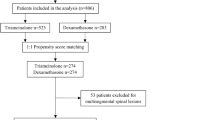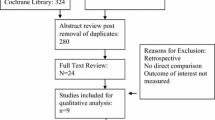Abstract
Objectives
To compare the outcomes of patients after interlaminar computed tomography (CT)-guided epidural injections of the lumbar spine with particulate vs. non-particulate steroids.
Methods
531 consecutive patients were treated with CT-guided lumbar interlaminar epidural injections with steroids and local anaesthetics. 411 patients received a particulate steroid and 120 patients received a non-particulate steroid. Pain levels were assessed using the 11-point numerical rating scale (NRS) and overall reported ‘improvement’ was assessed using the Patients Global Impression of Change (PGIC) at 1 day, 1 week and 1 month post-injection.
Descriptive and inferential statistics were applied.
Results
Patients receiving particulate steroids had statistically significantly higher NRS change scores (p = 0.0001 at 1 week; p = 0.0001 at 1 month).
A significantly higher proportion of patients receiving particulate steroids reported relevant improvement (PGIC) at both 1 week and 1 month post injection (p = 0.0001) and they were significantly less likely to report worsening at 1 week (p = 0.0001) and 1 month (p = 0.017).
Conclusion
Patients treated with particulate steroids had significantly greater pain relief and were much more likely to report clinically relevant overall ‘improvement’ at 1 week and 1 month compared to the patients treated with non-particulate steroids.
Key Points
• CT-guided epidural injections of the lumbar spine with particulate vs. non-particulate steroids.
• Good outcomes with particulate steroids.
• Less pain relief in patients with non-particulate steroids.
• Less improvement in patients with non-particulate steroids.

Similar content being viewed by others
References
Manchikanti L, Pampati V, Boswell MV, Smith HS, Hirsch JA (2010) Analysis of the growth of epidural injections and costs in the Medicare population: a comparative evaluation of 1997, 2002, and 2006 data. Pain Physician 13:199–212
Harkness EF, Macfarlane GJ, Silman AJ, McBeth J (2005) Is musculoskeletal pain more common now than 40 years ago?: two population-based cross-sectional studies. Rheumatology (Oxford) 44:890–895
Karamouzian S, Ebrahimi-Nejad A, Shahsavarani S, Keikhosravi E, Shahba M, Ebrahimi F (2014) Comparison of two methods of epidural steroid injection in the treatment of recurrent lumbar disc herniation. Asian Spine J 8:646–652
Friedly J, Nishio I, Bishop MJ, Maynard C (2008) The relationship between repeated epidural steroid injections and subsequent opioid use and lumbar surgery. Arch Phys Med Rehabil 89:1011–1015
Abdi S, Datta S, Trescot AM et al (2007) Epidural steroids in the management of chronic spinal pain: a systematic review. Pain Physician 10:185–212
Krych AJ, Richman D, Drakos M et al (2012) Epidural steroid injection for lumbar disc herniation in NFL athletes. Med Sci Sports Exerc 44:193–198
Parr AT, Diwan S, Abdi S (2009) Lumbar interlaminar epidural injections in managing chronic low back and lower extremity pain: a systematic review. Pain Physician 12:163–188
Conn A, Buenaventura RM, Datta S, Abdi S, Diwan S (2009) Systematic review of caudal epidural injections in the management of chronic low back pain. Pain Physician 12:109–135
Buenaventura RM, Datta S, Abdi S, Smith HS (2009) Systematic review of therapeutic lumbar transforaminal epidural steroid injections. Pain Physician 12:233–251
Price CM, Rogers PD, Prosser AS, Arden NK (2000) Comparison of the caudal and lumbar approaches to the epidural space. Ann Rheum Dis 59:879–882
Cohen SP, Bicket MC, Jamison D, Wilkinson I, Rathmell JP (2013) Epidural steroids: a comprehensive, evidence-based review. Reg Anesth Pain Med 38:175–200
Abram SE (1999) Treatment of lumbosacral radiculopathy with epidural steroids. Anesthesiology 91:1937–1941
Derby R, Lee SH, Date ES, Lee JH, Lee CH (2008) Size and aggregation of corticosteroids used for epidural injections. Pain Med 9:227–234
FDA - US Food and Drug Administration. Shoulder. Kenalog-10 (triamcinolone acetonide) injection and Kenalog-40 (triamcinolone acetonide) injection. http://www.fda.gov/safety/medwatch/safetyinformation/ucm262876.htm. Accessed 15 Feb 2015
US Food and Drug Administration FDA (2014) FDA drug safety communication: FDA requires label changes to warn of rare but serious neurologic problems after epidural corticosteroid injections for pain. http://www.fda.gov/downloads/Drugs/DrugSafety/UCM394286.pdf. Accessed 15 Feb 2015
Tinetti ME, Studenski SA (2011) Comparative effectiveness research and patients with multiple chronic conditions. N Engl J Med 364:2478–2481
Neumann PJ (2013) Communicating and promoting comparative-effectiveness research findings. N Engl J Med 369:209–211
Bensler S, Sutter R, Pfirrmann CW, Peterson CK (2015) Long term outcomes from CT-guided indirect cervical nerve root blocks and their relationship to the MRI findings - a prospective Study. Eur Radiol 25:3405–3413
Friedly JL, Comstock BA, Turner JA et al (2014) A randomized trial of epidural glucocorticoid injections for spinal stenosis. N Engl J Med 371:11–21
Kim D, Brown J (2011) Efficacy and safety of lumbar epidural dexamethasone versus methylprednisolone in the treatment of lumbar radiculopathy: a comparison of soluble versus particulate steroids. Clin J Pain 27:518–522
Kennedy DJ, Plastaras C, Casey E et al (2014) Comparative effectiveness of lumbar transforaminal epidural steroid injections with particulate versus nonparticulate corticosteroids for lumbar radicular pain due to intervertebral disc herniation: a prospective, randomized, double-blind trial. Pain Med 15:548–555
Manchikanti L, Candido KD, Kaye AD et al (2014) Randomized trial of epidural injections for spinal stenosis published in the New England Journal of Medicine: further confusion without clarification. Pain Physician 17:E475–E488
Manchikanti L, Candido KD, Singh V et al (2014) Epidural steroid warning controversy still dogging FDA. Pain Physician 17:E451–E474
Denis I, Claveau G, Filiatrault M, Fugere F, Fortin L (2015) Randomized double-blind controlled trial comparing the effectiveness of lumbar transforaminal epidural injections of particulate and nonparticulate corticosteroids for lumbosacral radicular pain. Pain Med 16:1697–1708
Park CH, Lee SH, Kim BI (2010) Comparison of the effectiveness of lumbar transforaminal epidural injection with particulate and nonparticulate corticosteroids in lumbar radiating pain. Pain Med 11:1654–1658
Lee SE, Kim DS, Lee WK et al (2010) Application of the Epstein criteria for prediction of clinically insignificant prostate cancer in Korean men. BJU Int 105:1526–1530
Stanczak J, Blankenbaker DG, De Smet AA, Fine J (2003) Efficacy of epidural injections of Kenalog and Celestone in the treatment of lower back pain. AJR Am J Roentgenol 181:1255–1258
Shakir A, Ma V, Mehta B (2013) Comparison of pain score reduction using triamcinolone vs. dexamethasone in cervical transforaminal epidural steroid injections. Am J Phys Med Rehabil 92:768–775
Lee JW, Park KW, Chung SK et al (2009) Cervical transforaminal epidural steroid injection for the management of cervical radiculopathy: a comparative study of particulate versus non-particulate steroids. Skeletal Radiol 38:1077–1082
Dreyfuss P, Baker R, Bogduk N (2006) Comparative effectiveness of cervical transforaminal injections with particulate and nonparticulate corticosteroid preparations for cervical radicular pain. Pain Med 7:237–242
Bose B (2005) Quadriparesis following cervical epidural steroid injections: case report and review of the literature. Spine J 5:558–563
Hodler J, Boos N, Schubert M (2013) Must we discontinue selective cervical nerve root blocks? Report of two cases and review of the literature. Eur Spine J 22:S466–S470
Wallace MA, Fukui MB, Williams RL, Ku A, Baghai P (2007) Complications of cervical selective nerve root blocks performed with fluoroscopic guidance. AJR Am J Roentgenol 188:1218–1221
Rozin L, Rozin R, Koehler SA et al (2003) Death during transforaminal epidural steroid nerve root block (C7) due to perforation of the left vertebral artery. Am J Forensic Med Pathol 24:351–355
Ludwig MA, Burns SP (2005) Spinal cord infarction following cervical transforaminal epidural injection: a case report. Spine (Phila Pa 1976) 30:E266–E268
Meyer HJ, Monticelli F, Kiesslich J (2005) Fatal embolism of the anterior spinal artery after local cervical analgetic infiltration. Forensic Sci Int 149:115–119
Popescu A, Lai D, Lu A, Gardner K (2013) Stroke following epidural injections–case report and review of literature. J Neuroimaging 23:118–121
Ziai WC, Ardelt AA, Llinas RH (2006) Brainstem stroke following uncomplicated cervical epidural steroid injection. Arch Neurol 63:1643–1646
US Food and Drug Administration FDA (2011) FDA - US Food and Drug Administration. Shoulder. Kenalog-10 (triamcinolone acetonide) injection and Kenalog-40 (triamcinolone acetonide) injection. http://www.fda.gov/safety/medwatch/safetyinformation/ucm262876.htm. Accessed 15 Jan 2015
Wybier M, Gaudart S, Petrover D, Houdart E, Laredo JD (2010) Paraplegia complicating selective steroid injections of the lumbar spine. Report of five cases and review of the literature. Eur Radiol 20:181–189
Benzon HT, Chew TL, McCarthy RJ, Benzon HA, Walega DR (2007) Comparison of the particle sizes of different steroids and the effect of dilution: a review of the relative neurotoxicities of the steroids. Anesthesiology 106:331–338
Tiso RL, Cutler T, Catania JA, Whalen K (2004) Adverse central nervous system sequelae after selective transforaminal block: the role of corticosteroids. Spine J 4:468–474
Rathmell JP, Aprill C, Bogduk N (2004) Cervical transforaminal injection of steroids. Anesthesiology 100:1595–1600
Huntoon MA (2005) Anatomy of the cervical intervertebral foramina: vulnerable arteries and ischemic neurologic injuries after transforaminal epidural injections. Pain 117:104–111
Rathmell JP, Benzon HT (2004) Transforaminal injection of steroids: should we continue? Reg Anesth Pain Med 29:397–399
Lechmann M, Peterson CK, Pfirrmann CW, Hodler J (2013) Lumbar nerve root injections: a prospective cohort outcomes study comparing age- and gender-matched patients who returned an outcomes-based postal questionnaire with patients who did not return the postal questionnaire. Skeletal Radiol 42:1429–1435
Kremer S, Pfirrmann CW, Hodler J, Peterson CK (2012) Imaging-guided lumbar facet injections: is there a difference in outcomes between low back pain patients who remember to return a postal questionnaire and those who do not? Insights Imaging 3:411–418
Acknowledgments
The scientific guarantor of this publication is Susanne Bensler. The authors of this manuscript declare no relationships with any companies whose products or services may be related to the subject matter of the article.
The authors state that this work has not received any funding. No complex statistical methods were necessary for this paper. Institutional review board approval was obtained. Written informed consent was obtained from all subjects (patients) in this study. Methodology: retrospective, diagnostic or prognostic study, performed at one institution.
Author information
Authors and Affiliations
Corresponding author
Rights and permissions
About this article
Cite this article
Bensler, S., Sutter, R., Pfirrmann, C.W.A. et al. Is there a difference in treatment outcomes between epidural injections with particulate versus non-particulate steroids?. Eur Radiol 27, 1505–1511 (2017). https://doi.org/10.1007/s00330-016-4498-9
Received:
Revised:
Accepted:
Published:
Issue Date:
DOI: https://doi.org/10.1007/s00330-016-4498-9




